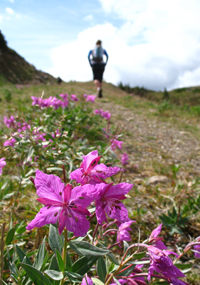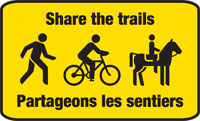
Mark Bradley
Protecting the park
Jasper National Park
Managing our use
Managing our use

Stay on the trails, vegetation is fragile.
Humans have an impact in the backcountry. Vegetation is fragile, especially at higher elevations, wildlife are not habituated to people, and backcountry users are seeking quiet and solitude.
Park management regulations and guidelines are in place to minimize our impact on the wilderness and each other. They include:
Group size limits
- The group-size maximum is ten people in semi-primitive and primitive areas.
- The group-size maximum is six people in wildland areas.
Tent quotas
- One tent per site is permitted in semi-primitive areas.
- Four tents per campground is permitted in primitive areas.
Length-of-stay limits
- Three nights is the maximum length-of-stay at most semi-primitive and primitive areas.
- Two nights is the maximum length-of-stay at Fisherman's Bay and Coronet Creek campgrounds (Maligne Lake), Snowbowl, Curator and Tekarra campgrounds (Skyline Trail), Jonas Cut-Off and Four-Point campgrounds (Brazeau Loop) and all wildland areas.
- Fires are only permitted in the metal fire grates provided in semi-primitive and primitive areas.
- Fires are not permitted in wildland areas.
- Due to lack of wood, fires are not permitted in The Tonquin Valley, on the Skyline Trail, at Jonas Cut-Off and Four-Point campgrounds on the Brazeau Loop and all wildland areas.
- Wild animals see dogs as either prey or predator. They can provoke confrontations with wildlife and affect your safety. This is why dogs must be kept on leash while in a national park.
- Please note that dogs are not allowed in some backcountry areas to protect caribou (see map).
Leave no trace
Leave no trace
Garbage
Please—pack it in and pack it out! You are responsible for everything you take into the backcountry and this includes garbage. Do not dispose of garbage in pit toilets—it attracts animals.
Shortcutting trails
Shortcutting between trail switchbacks damages both the soil and plant life. This not only ruins the look of an area, but makes it susceptible to further damage by erosion.
Collecting natural or cultural objects
Rocks, fossils, horns, antlers, wildflowers, nests and all other natural or historical objects in a national park are protected by law. Leave them as you found them for others to enjoy.
Camping
Please camp only at the campsites indicated on your backcountry camping permit and use the tent pads (where provided). Check with park staff for special restrictions.
Washing
To wash yourself or your dishes, carry water 70 m away from streams or lakes and use small amounts of biodegradable soap. Strain out those last bits of food waste and pack them out. Disperse strained water on land.
Campfires
Campfires are a luxury in the mountains and are not permitted in some areas (see map). If you choose to have a fire, use the metal fireboxes provided, keep your fire small and use only deadfall. Tend to your fire at all times and extinguish it completely before you move on. Gas stoves are cleaner and more efficient for cooking. We recommend you use one.
Food storage
To reduce your campsite's attractiveness to bears and other wildlife, all food, garbage, toiletries and cooking equipment must be hung from the food storage cables or food lockers provided at designated campsites. In wildland camping areas, bear-resistant containers are mandatory to store food. Please clean food lockers after use.
Human waste
Use the pit toilets provided. When there are no facilities nearby, select a spot away from trails, campsites and at least 70 m from water sources. Dig a hole 12 to 16 cm. to the dark-coloured, biologically active soil layer. Loosely fill the hole with soil afterward. Use as little toilet paper as possible and carry it out or burn it.
For more information on low impact travel in the backcountry contact:
leavenotrace.ca or 1-877-238-9343.
Share the trail
Share the trail

Hikers, horse parties and mountain bikers often share trails and campsites in certain parts of the park. Respect for others can go a long way toward reducing conflicts. Make noise if you are travelling quickly or silently, move off the trail to allow larger parties to pass, and avoid sudden movement around horses as they may spook.
Woodland Caribou
The woodland caribou found in Jasper are a threatened species. Less than 60 caribou are left in south Jasper.
What you can do to help woodland caribou:
- Stay on designated trails and if you see caribou give them space.
- Dogs are not allowed in occupied caribou habitat (see map).
- Avoid hiking in caribou habitat during calving season (June – early July) and rut season (late September to early October).
To find out more about caribou conservation in the mountain national parks, visit www.pc.gc.ca/caribou.
- Date modified :